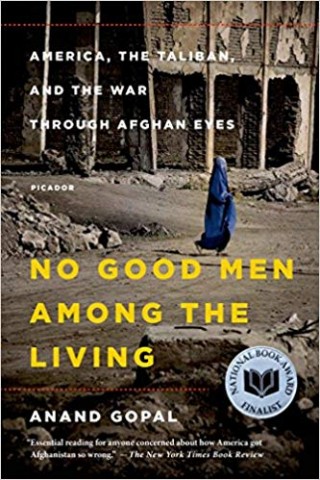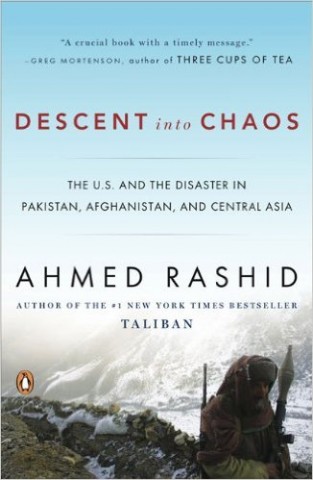Anand Gopal was a Pulitzer finalist and won the Ridenhour Prize for "No Good Men Among the Living: America, the Taliban, and the War through Afghan Eyes" (2014). For those interested in Afghanistan, I've covered books by Ahmed Rashid, William Dalrymple and Stephen Saideman elsewhere. Gopal's book is an excellent read and presents the counter-narrative to Saideman - rather than the foreign experience, this is Afghan experience. This is not an academic text, as Dalrymple's is, but offers a wealth of insight. The New York Times Book Review described Gopal's book as "essential reading for anyone concerned about how American got Afghanistan so wrong". I could not agree more. Some notes:
- Given the recent shift to talk with the Taliban, history shows how other paths were available. Before the war, the "Taliban agreed to place bin Laden on trial, but Washington, not trusting the impartiality of Afghan courts, demanded his extradition to US soil. The Taliban, for their part, doubted the objectivity of the American legal system. They agreed to hand him over only to a neutral Islamic country for trial, which Washington rejected." (p. 12)
- The shallow vision of the socio-political context resulted in tremendous errors: "Karzai understood what his American friends did not yet grasp: not only individuals but entire tribal communities were winners and losers in the invasion. Time would reveal this in a most painful way." (p. 44)
- Finger pointing often means four fingers pointing at oneself, and one at the other: "Looking to keep the war fueled, Washington - where the prevailing ethos was to bleed the Russians until the last Afghan - financed textbooks for schoolchildren in refugee camps that were festooned with illustrations of Kalashnikovs, swords, and overturned tanks." (p. 56)
- The (short-term) consequentialist thinking driving decision making, disregarding the lives lost in the means taken: "when Zbigniew Brzezinski, who as national security advisor to President Carter helped to initiate Washington's anti-Soviet mujahedeen policies, was asked in the late 1990s whether he had any regrets, he replied: "What is more important in the history of the world? The Taliban or the collapse of the Soviet empire? Some stirred-up Muslims or the liberation of Central Europe and the end of the Cold War?" (p. 67)
- The cold reality: "Save for a few lone wolf attacks, US forces in Kandahar in 2002 faced no resistance at all. The terrorists had all decamped or abandoned the cause, yet US special forces were on Afghan soil with a clear political mandate: defeat terrorism. How do you fight a war without an adversary? Enter Gul Agha Sherzai - and men like him around the country. Eager to survive and prosper, he and his commanders followed the logic of the American presence to its obvious conclusion. They would create enemies where there were none, exploiting the perverse incentive mechanism that the Americans - without them realizing it - had put in place. Sherzai's enemies became American enemies, his battles its battles. His personal feuds and jealousies were repackaged as "counterterrorism," his business interests as Washington's. And where rivalries did not do the trick, the prospect of further profits did." (p. 109)
- Creating enemies: "They were forced to kneel there for hours, their hands bound behind them. Some passed out from the pain. Some lost sensation in their hands and feet. Then they were marched into a room and made to strip and stand in front of American soldiers for inspection, inspiring a humiliation that, in the Pashtun ethos, was difficult to even imagine. "When they made us walk naked in front of all those Americans," captive Abdul Wahid later told a reporter, "I was praying to God to let me die. If someone could have sold me a poisoned tablet for $100,000, I would have bought it." In a final act of emasculation, soldiers appeared with clippers. One by one the captives beards were shorn off, and many of them broke down in tears. Some, for resisting, had their eyebrows removed as well... After five days they were brought to Kandahar's soccer stadium and released [finding them to have supported the US]. A crowd of thousands, who had made the trip from Maiwand, was there to greet them. A few months earlier many of these farmers had packed the stadium seats waving the new Afghan flag and chanting in favor of the coming loya jirga. Now, for the first time, anti-American slogans filled the air." (p. 110-111)
- "Reading the official list of charges against the rest gives a sense of the farce the system had become. One inmate was accused, among other crimes, of supporting the political organization of Ahmed Shah Massoud, the pro-Western Northern Alliance leader murdered by al-Qaeda. Another was alleged to have been a member of Herakat-i-Inquilabi—an anti-Soviet mujahedeen group, backed by the United States, that had been defunct since the mid-1990s. Inmate Muhammad Nasim arrived at Guantanamo accused of working as a deputy to Rashid Dostum, the pro-US warloard and former Gelam Jam militia leader who, prison authorities mistakenly believed, had "defected to the Taliban in 1998"—or so Nasim's classified filed stated. In fact, Dostum had been a member of the Northern Alliance and a staunch anti-Taliban fighter, even winding up on the CIA payroll during the 2001 invasion. Nasim was also accused of being the former Taliban deputy minister of education, even though records indicate there was no person by that name in that position. Abdullah Khan found himself in Guantanamo charged with being Khairullah Khairkhwa, the former Taliban minister of the interior, which might have been more plausible—if Khairkhwa had not also been in Guantanamo at the time." (p. 144-145)
- "Of the $557 billion that Washington spent in Afghanistan between 2001 and 2011, only 5.4 percent went to development or governance. The rest was mostly military expenditure, a significant chunk of which ended up in the coffers of regional strongmen like Jan Muhammad. In other words, while the United States paid nominal amounts to build the Afghan state, it fostered a stronger and more influential network of power outside the state." (p. 273)


